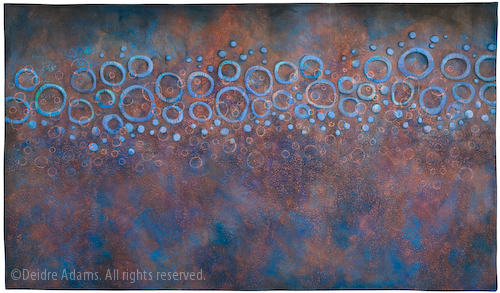
Potential. ©2003 Deidre Adams.
I’m sure many of you have noticed how language in the art world can be extraordinarily abstruse at times. (I’m using this word intentionally so I can show off how erudite I am; to impress you lowly commoners with my recondite credentials.)
I’m taking a class right now called Art of the 20th & 21st Centuries. The topic is really interesting, and the instructor is great. Her lectures are clear and informative, and we have some great discussions in the class. I love learning about the progression of the different movements throughout this time.
BUT … the textbook, “art since 1900: modernism, antimodernism, postmodernism,” is an enormous stinking pile of self-serving gobbledygook. The authors have no intention of being informative, so that the reader might actually learn something valuable. Rather, it reads as though they are just sitting around in some kind of academic salon pontificating and showing off to one another.
An example of a typical writing exercise question:
What is aesthetic autonomy? What do you think the authors mean, then, when they talk about “artistic acts” negating or refusing “instrumentalized experience”?
Well, okay, you might think to yourself. This probably has something to do with Dada, an “anti-art” movement that formed as a protest against the “bourgeois capitalist society that had led people into war,” expressing their ideas in ways that “appeared to reject logic and embrace chaos and irrationality.”
But in the textbook, the avoidance of actually defining “aesthetic autonomy” reads like this:
German philosopher Jürgen Habermas (born 1929) has defined the formation of the bourgeois public sphere in general and the development of cultural practices within that sphere as social practices of subjective construction of bourgeois individuality. These processes guarantee the individual’s identity and historical status as a self-determining and self-governing subject. One of the necessary conditions of bourgeois identity was the subject’s capacity to experience the autonomy of the aesthetic, to experience pleasure without interest.
Self-determining and self-governing, well that makes sense more or less, but how, exactly, does one go about experiencing pleasure without interest?
As far as “instrumentalized experience,” we have this gem:
The modernist aesthetic of autonomy thus constituted the social and subjective sphere from within which an opposition against the totality of interested activities and instrumentalized forms of experience could be articulated in artistic acts of open negation and and refusal. Paradoxically, however, these acts served as opposition and — in their ineluctable condition as extreme exceptions from the universal rule — they confirmed the regime of total instrumentalization. One might have to formulate the paradox that an aesthetics of autonomy is thus the highly instrumentalized form of noninstrumentalized experience under liberal bourgeois capitalism.
Huh? My brain hurts. Here’s a good, funny post on “artspeak” by Jason Brockert that we all ought to take heed of. Take a look at his web site, too — some wonderful, thought-provoking work.



